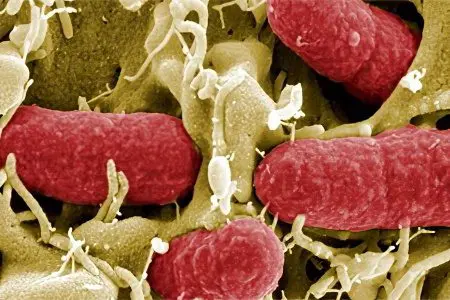Contents
The mucous membrane, which promotes the digestion and absorption of nutrients, lines the inner surface of the gastrointestinal tract. To protect against mechanical injury, from the effects of acids and alkalis, its cells secrete mucus that envelops the stomach and intestines from the inside.
What does white mucus in stool mean?

With injury and inflammation of the mucous membrane, mucus secretion increases. In the normal state, the mucus is not noticeable in the feces, it is evenly mixed with the feces. With irritation of the mucous membrane, an increased amount of mucus can be easily determined by visual inspection of the products of defecation, during the coprogram.
A coprogram is a study of feces that allows you to determine the state of the gastrointestinal tract, the presence of digestion and absorption processes, diseases of the stomach and intestines.
Parameters determined by the coprogram:
Color and texture of feces;
The presence of epithelium, starch, mucus;
The number of erythrocytes and leukocytes;
The presence of connective tissue, muscle fibers;
The volume of iodophilic flora, fatty acids.
The color and structure of the mucus found in the feces depends on the cause of its hypersecretion and the nature of the damage:
Yellow and green mucus – the presence of a bacterial process, an admixture of pus;
Clear mucus – catarrh;
An admixture of blood, a pinkish hue of mucus – the presence of an ulcer of the mucous membrane, hemorrhagic inflammation.
Causes of white mucus in the stool

Depending on the cause of hypersecretion of mucus, its consistency and therapy of the pathological process depend.
Factors affecting the appearance of mucus in the stool:
ARVI. With a respiratory infection caused by adeno- and enterovirus, parainfluenza viruses, catarrh of the intestinal wall occurs. In addition, the patient swallows the mucous discharge of the nasopharynx. Mucus in the stool with ARVI has a transparent consistency, its volume is small. For the treatment of this condition, antiviral drugs are prescribed – Interferon, Arbidol.
Side effects of certain drugs and products. A small amount of clear mucus may appear as a result of taking NSAIDs, medicines for flatulence, smoking, drinking coffee. After the abolition of the above drugs, the condition returns to normal.
Intestinal infectious diseases. Bacterial infections provoke the release of a large amount of mucus of various structure and consistency. With salmonellosis, a small amount of mucus accompanies frequent swamp-colored stools. With dysentery, the mucus becomes green, it contains pus and an admixture of blood. During a staph infection, mucus accompanies frequent, bloody, frothy stools.
Treatment of intestinal infections – taking drugs from the group of nitrofurans (Furazolidone, Ersefuril, Eneterofuril) or from the group of cephalosporins.
Viral infections of the intestine. With colienterocolitis, yellow mucus with whitish impurities is found in the feces against a watery yellow-green color. With rotavirus infection, which causes malabsorption and digestion, mucus accompanies frequent stools with symptoms of dehydration. Therapy – taking Viferon, Kipferon, drugs for rehydration (Hydrovit, Regidron), solutions for parenteral administration.
parasitic infections. Mucus in the feces with helminthiasis accompanies frequent stools with an admixture of blood and abdominal pain. Additionally, a decrease in appetite, anemia, and allergic manifestations are diagnosed. Therapy of parasitic infections is carried out with Mebendazole, Niridazole, Piperazine, Meironidazole, Tinidazole, Chloxil.
Candidiasis. Entering the intestinal lumen of the mycelium of the fungus of the genus Candida causes the release of white mucus into the feces. Treatment – taking Griseofulvin, Amphotericin.
Autoimmune intestinal inflammation (ulcerative colitis, Crohn’s disease). Mucus with blood and pus is released against the background of diarrhea, fever, pain along the intestines. Treatment – taking drugs from the group of cytostatics, glucocorticoids, sulfalazines.
Spastic colitis. Mucus with blood is accompanied by constipation and diarrhea with a spastic component. Treatment – sanitation of the intestines with Enterofuril, Furozolidone, taking antispasmodics, probiotics, Enterol.
Dysbacteriosis. The picture of colonization of the intestine with clostridium includes mucus against the background of an unstable stool, abdominal pain, and loss of appetite. Treatment of the disease is carried out with intestinal antiseptics (Furazolidone, Enterofuril, Metronidazole), probiotics (Linex, Bifiform, Bifikol, bifidumbacterin).
Raw food diet, starvation. Dietary disorders cause depletion of the mucosa, its atrophy and irritation with coarse food, which provokes the release of copious amounts of mucus.
Pancreatitis. Mucus hypersecretion is caused by irritation of the mucosa with a large amount of pancreatic enzymes. Treatment – infusion of Furosemide, Diakarba, intake of enzymes, diet, surgery.
Diverticulosis intestines The protrusion of the intestinal wall causes brown mucus against a background of small bleeding in the small intestine. Therapy – surgical treatment after intestinal sanitation and restoration of its microflora.
Proctitis, proctosigmoiditis. Mucus and blood in the feces appear along with pain against the background of irritations with enemas, chemical and mechanical damage. Therapy – antibacterial, anti-inflammatory drugs, taking antispasmodics and laxatives.
Malignant tumors of the intestine. With an oncological lesion of the intestine, mucus with an admixture of blood appears in the stool against the background of intestinal obstruction and chronic pain syndrome. Treatment – removal of the neoplasm, radiation and chemotherapy.
Causes of white mucus in the feces of a newborn

Immediately after birth, the gastrointestinal tract of the newborn is sterile. In the first days of life, it is populated by microorganisms, the biocenosis of which contains both valuable lacto- and bifidobacteria, as well as saprophytes and conditionally pathogenic microorganisms.
During the first 2-3 weeks of a baby’s life, a balance is established between different types of bacteria in his intestines. Transitional stool contains mucus, has a greenish tint. Once an equilibrium is established, the consistency of the stool may change, as well as its color and frequency.
Factors affecting the appearance of mucus in the stool in infants:
Intestinal dysbiosis. The predominance of enterobacteria, clostridia, Staphylococcus aureus, Klebsiella over lactic acid bacteria cause flatulence, constipation, and the release of a large amount of mucus streaked with blood. If the mucus takes on a reddish tint, this is a sign of ulceration on the mucous membrane. Therapy of dysbacteriosis – taking Enterofuril, bacteriophages, Stop Diara, a course of treatment with probiotics (Linex, Normoflorin, Bifiform, Primadophilus). To prevent recurrence of dysbacteriosis, you need to carefully care for the baby.
Bacterial and viral intestinal infections. With the introduction of salmonella, dysentery bacillus, toxic infections into the child’s body, inflammation of the intestinal mucosa develops. This circumstance causes the release of a large amount of mucus with clots. Diagnosis of infections – bacteriological culture of feces. These conditions are dangerous in that the child can quickly die from dehydration caused by diarrhea and vomiting.
Medicines for flatulence. Medications – defoamers (Bobotik, Espumizan, Bebicalm) can mimic mucus in the stool in an infant. After stopping the medication, the admixture of mucus is no longer noted.
Violation of the rules for the introduction of complementary foods. The introduction of certain vegetables into the diet can provoke the release of a large amount of stool. The consistency of the stool changes, it becomes liquid or, conversely, more dense, acquires a green color.
lactase failure. Deficiency of the enzyme lactase, which ferments milk, causes fermentative dyspepsia. Its symptoms are the release of a large amount of mucus, the admixture of milky inclusions in the feces, gases, loose stools, and abdominal pain. Diagnosis – a study of feces for carbohydrates, treatment – a diet for a nursing mother, the introduction of lactase preparations to an infant, a lactose-free mixture is chosen for artificial feeding.
Allergy, atopic dermatitis. External manifestations in the form of weeping skin, peeling of the skin of the cheeks, may be accompanied by irritation of the intestinal mucosa. As a result, an increased amount of mucus is secreted.
Coryza. Swallowed mucus from the nasopharynx enters the intestines and is diagnosed in the feces of a child who cannot blow his nose on his own.
Intestinal invaginitis. When squeezing a part of the child’s intestines with another part of it, severe pain appears, gushing vomiting, loose bloody stools with an admixture of mucus. A day after the first symptoms of intestinal vaginitis appear, the feces are converted into lumps of mucus mixed with blood. Emergency surgeon assistance is required – a barium enema to straighten the intestines, otherwise the child may die from pain shock.
What to do if white mucus appears in the stool?

If mucus in the stool in children appears sporadically, most likely, its appearance is not associated with any pathology. Eliminating the cause of this condition, most often a violation of the diet, will completely eliminate the problem. The increase in this symptom and the addition of pathology with other symptoms is a reason to see a doctor.
Research to clarify the diagnosis:
Micro- and macroscopy of feces;
Coprogram;
Bacterial culture of feces;
Colonoscopy;
Ultrasound and x-ray of the intestines, stomach;
General and biochemical blood test.
According to the results of the study, treatment is prescribed, the scheme of which is due to the cause of the pathology. If it is based on an infectious factor, antibiotics, absorbents, anti-inflammatory drugs are prescribed. With dysbacteriosis, the balance of the intestinal microflora is restored. To normalize the production of mucus, a special diet is prescribed that contains foods that do not provoke hypersecretion of mucus.










اگر پاخانے کے سات زردی کے بغیر انڈاجو ہے اگر اسی طرہ ہردن پاخانا اجایے تو یے کیا وجوہات ہے